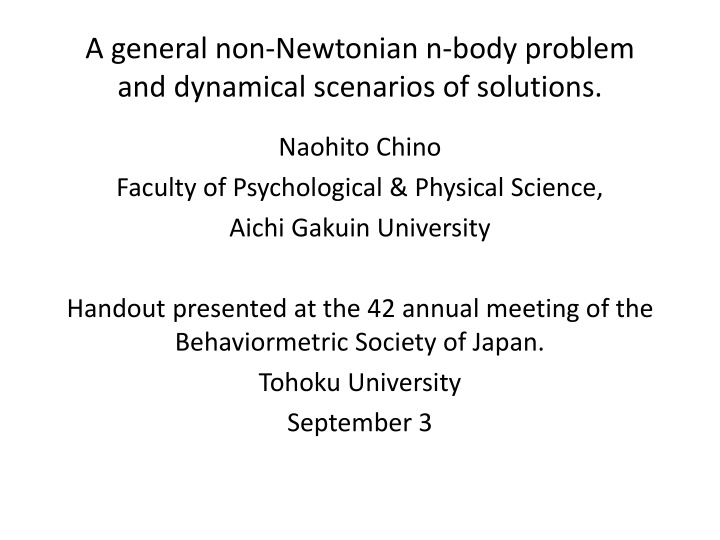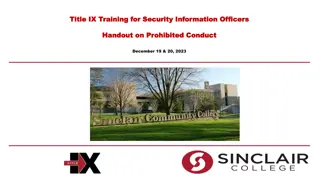
Dynamical Systems and Graph Theory in Complex Networks
Explore the intersection of dynamical systems, graph theory, and complex networks, tracing back to early theories and recent developments. Learn about the formation of group structures in natural phenomena and the small-world model in network connectivity.
Download Presentation

Please find below an Image/Link to download the presentation.
The content on the website is provided AS IS for your information and personal use only. It may not be sold, licensed, or shared on other websites without obtaining consent from the author. If you encounter any issues during the download, it is possible that the publisher has removed the file from their server.
You are allowed to download the files provided on this website for personal or commercial use, subject to the condition that they are used lawfully. All files are the property of their respective owners.
The content on the website is provided AS IS for your information and personal use only. It may not be sold, licensed, or shared on other websites without obtaining consent from the author.
E N D
Presentation Transcript
A general non-Newtonian n-body problem and dynamical scenarios of solutions. Naohito Chino Faculty of Psychological & Physical Science, Aichi Gakuin University Handout presented at the 42 annual meeting of the Behaviormetric Society of Japan. Tohoku University September 3
1 Introduction Formation of group structures and their changes over time are ubiquitous in nature through interactions among constituent members. These members can be celestial bodies, nations, humans, animals, neurons, cells, electrons, and so on. Two major theories which deal with such a phenomena may be dynamical system theory and graph theory.
Although the theory of dynamical systems is said to go back to the pioneering work of Henri Poincar in the late 19th century (e.g., Bhatia & Szeg , 1970), the studies on dynamical system may be said to have begun in ancient Babylonia (e.g., Alexander, 1994) and elsewhere. By contrast, graph theory is said to go back to the work of Euler in the early 18th century (e.g., Harary, 1969).
Recently, there has been increasing atten- tion paid to the study of complex networks in the social and natural sciences, essentially based on graph theory, since the appear- ance of the works of Watts and Strogatz (1998) and Barab si and Albert (1999). Watts-Strogatz (1998) Nature Barab si-Albert (1999) Science Academic Search Premier & PsycInfo complex networks
1991 (22), 2002 (208), 2009 (1036), 2013 (1492 ) 2001 100 2002 100 2009 1000 (2013) 2000 On the one hand, Watts and Strogatz (1998) proposed the small-world model which is characterized by the property that two nodes can be connected with a path of a few links
only (Barabsi & Oltvai, 2004). Here, nodes (vertices) and paths (edges) are usually as- sumed in graph theory, and these corres- pond to members and interactions between members, respectively. path (edge) node (vertex)
Newman, M. E. J. (2006). Phys. Rev. E, 74, (N=2,742) , 2013, p.144
On the other hand, Barabsi and Albert (1999) pointed out that many large net- works have a common property which is that the distribution function of vertex con- nectivities obeys a scale-free power law. node node edge k k P(k) k ? ? ? ?
Barabsi and Albert (1999). Science, 286, Fig. 1 A N=212,250, B WWW N=325,729, C N=4,941 log-log 2.3, 2.1, 4.0
Although these quantifiable tools of complex networks have provided various possibilities to understand group structure and its evolution, there seems to be a fun- damental shortfall in these tools, which is inherited from graph theory. That is, in graph theory the existence or nonexistence of each path is binary.
However, strengths of interactions bet- ween members of group in the actual sys- tem are thought of as continuous and vary in time. Considering this point, an alterna- tive theory, i.e., dynamical system theory, seems to be more promising. (weighted digraph) edge
In ecological networks, especially in food- web there have been a body of literature which utilize dynamical system theory in modelling change in predator-prey rela- tionship over time. Some of them use non- linear difference equation model, while others nonlinear differential equation mod- el (e.g., Chesson & Warner, 1981; Chesson & Warner, 1981; Lotoka, 1910, 1925; McCann
et al., 1998; Voltera, 1926). For example, MaCann et al. (1998) pro- posed an interesting nonlinear differential equation model as a food-web model, in which they considered food-webs compos- ed of three or four species, one being the top predetor, another being a resource species, the other being one or two con- sumer species. They examined the effects
of relative interaction strengths on change in densities of species over time. Results indicated that chaotic behaviors occur when the interaction strengths as bifurca- tion parameters of the system vary as time proceeds Nature . Chesson and Warner (1981) proposed a lottery model which is described by a set of nonlinear difference equations. This model
explains a certain coexistence phenome- non of species. However, these models discussed above merely deal with change in numbers or density of species. In other words, the number of dimensions of the state spaces of these models is equal to the number of species. The same is true for the neural
network models (Amari, 1972; Aihara et al., 1990). Moreover, most of the network models discussed up to now assume that the state space of the system is real, except for the complex neural network models (i.e., Aizenberg et al., 1971, 2000; Hirose, 1992; Suksmote et al., 2005). In this paper, we propose a revised ver- sion of the complex difference equation
model proposed by Chino (2000, 2002, 2006). In section 2 we shall discuss the necessity for distinguishing a real diffe- rence system model from a complex diffe- rence system model, using the notion of differentiability of the difference equation under consideration. In section 3 we shall point out that our difference equation model can be interpreted as a non-Newton-
ian n-body problem, and that some curi- out results such as ? -type noise can be seen from a small simulation study of our model.
2 Real vs. complex difference system model Until recently we have called our diffe- rence equation model the `complex diffe- rence system model' (2000, 2002, 2006). This model is defined as follows:
Here, ??,?denotes the coordinate vector of member j at time n in a p-dimensional Hil- bert space or a p-dimensional indefinite
metric space. Moreover, m denotes the degree of the vector function ?(?)??,? ??,? in Eq. (2), which is assumed to have the maximum value q. Furthermore, a (?,?) coefficient of the term is a real constant ? ? ?(?) ?,? ?(?) are, respectively, the norm , ?,? r(?,?) and the argument of ??,?at time n on dimen- sion ?. Usually, both r(?,?) ?,?and (?,?) ?,? and (?,?) are ?,? ?,?
Independent of m. It is apparent that the two terms r(?,?) of z (?) means that ??,?+1in Eq. (1) is not a holo- morphic function, since the complex con- jugate of ??,?+1is not differentiable in the complex space (e.g., Bak & Newman, 1982). As a result, we can not utilize the theory of complex dynamical systems in and (?,?) ?,?are functions ?,? ?,?and its complex conjugate. This
mathematics, as far as we assume Eq (4). Of course, if we assume Eq. (4) and if we identify the state space of our complex difference system as 2p-dimensional real space, we need not drop Eq. (4). However, we have recently dropped it, in order to utilize the theory. Furthermore, we have made a new assumption that weights,
w(?,?) ?,?, ?=1, , p, of Eq. (4) are complex constants in general. Eq. (4)
(dim.?=1, deg. m=1) imaginary Wjk,n(?,m) (zj,n zk,n) positive direction of HFM Zk,n Zk,n+1 j,n(?,m) Zj,n Zj,n+1 real
We have recently added two terms in Eq. (1), ? ??,? and ?0, the former being a control (e.g., Elaydi, 1999; Ott et al., 1990) and the latter a complex constant vector. Here, ? ??,? is a vector function of a complex vector ??,?and ?0is a complex constant vector.
A non-Newtonian n-body problem As discussed in the introductory section, number of dimensions of the state spaces in complex networks is equal to the num- ber of members. In these network models, if the number of members increases, the number of dimensions becomes enormous. In order to avoid this, we utilize the Chino- Shiraiwa theorem in psychometrics (Chino
& Shiraiwa, 1993). It enables us to reduce the number of dimensions in complex net- works drastically, depending on the manner of interactions in these networks. This theorem also teaches us the nature of the space in which we embed members. If we can observe a real relationship matrix whose element is composed of the intensity of interactions among members at some
instant in time, we can estimate the num- ber of dimensions using this theorem. The space may either be the complex Hilbert space or the indefinite metric space, accor- ding to the theory. As a result, the prob- lem given in the beginning of the Introduc- tory section can be thought of as a general non-Newtonian n-body problem in some finite-dimensional complex space, in which
interactions are generally asymmetric. We have recently proven that even a dyadic relation model, which is a special case of the new models in the revised version, includes a Mandelbrot set as a special case (e.g., Mandelbrot, 1977). Furthermore, we have recently found that even a special triadic relation model some-
times exhibits the so-called ?-type noise (e.g., Kohyama, 1984). We shall show some results of a small simulation study on our revised version of the complex difference equation model at the conference. ? 1noise 1/f ? 2noise Brown Einstein (1905)
A small simulation study 2p chino, N. (2014). HP, (in English). MATLAB .
Chino, N. (2014). A Hilbert state space model for the formation and dissolution of affinities among members in informal groups. Supplement of the paper presented at the workshop on The Problem Solving through the Applications of Mathematics to Human Behaviors by the aid of The Ministry of Education, Cul- ture, Sports, Science and Technology in Japan (pp.1-24). Einstein, von A. (1905). ber die von der molekularkinetishen Theorie der W rme geforderte Bewegung von in ruhenden Fl ssigkeiten suspendierten Teilchen. Annalen der Physik, 18, 549-560. Newman, M. E. J. (2006). Finding community structure in net-
works using the eigenvectors of matrices. Physical Review, E, 036104. Page, C. H. (1952). Instantaneous power spectra. Journal of Ap- plied Physics, 23, 103. Priestley, M. B. (1965). Evolutionary spectra and nonstationary process. Journal of the Royal Statistical Society B, 27, 204- 237. (2013).





